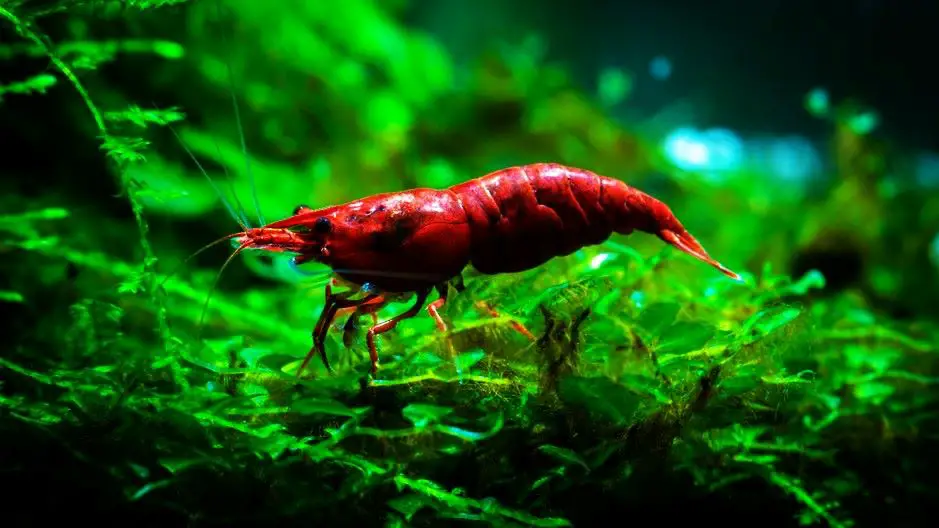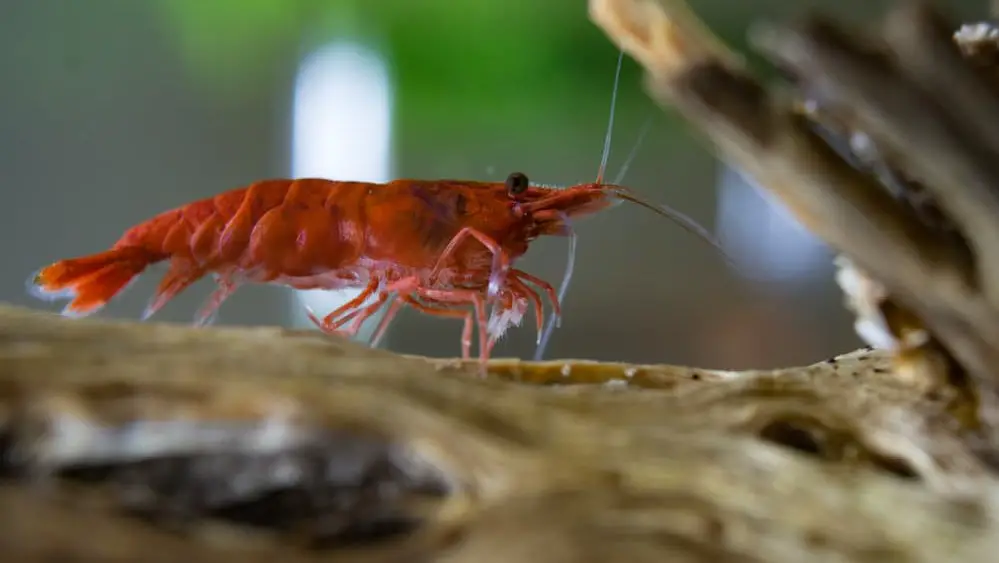Have you ever noticed a peculiar white ring around your shrimp’s body, only to find them lifeless a short while later? This phenomenon, often referred to as the “white ring of death,” has puzzled shrimp keepers for years. It’s a heartbreaking sight, especially when you’ve nurtured your shrimp with utmost care, only to lose them to this mysterious condition.
The white ring of death in shrimp is most likely caused by poor nutrition. This conclusion is based on personal experiences where a change in diet, specifically the introduction of powdered goldfish flakes , significantly reduced the occurrence of this condition.
, significantly reduced the occurrence of this condition.
Hello there, fellow shrimp enthusiast! I’ve been on this shrimp-keeping journey for quite a long time now, and it’s been a rollercoaster of emotions, to say the least. I’ve had my fair share of challenges, one of which was the dreaded white ring of death. It was a baffling issue that seemed to strike without warning, leaving me feeling helpless and frustrated.
I breed thousands of neocaridina, like the vibrant cherry shrimp, and for a while, it seemed like the white ring of death was an inevitable part of the process. But I refused to accept that. I started experimenting with their diet, introducing powdered goldfish flakes into their meals. And guess what? The white ring of death became a rare sight in my tanks!
This was a significant revelation for me. It suggested that the white ring of death was not a result of the large water changes I was doing, as some theories suggested, but rather a consequence of poor nutrition. It was a relief to find a solution, but it also made me realize the importance of understanding the nutritional needs of my shrimp.
So, if you’re struggling with the white ring of death in your shrimp tanks, take a closer look at their diet. It might just be the key to solving this mystery. And remember, every challenge we face in shrimp keeping is an opportunity to learn and grow. So, keep on shrimping, and let’s continue this journey together!
What are the Symptoms of the White Ring of Death in Shrimp?
The white ring of death in shrimp is a condition that’s as ominous as it sounds. It’s named for the most visible symptom: a stark, white band that appears around the shrimp’s body. This ring is typically located between the carapace and the thorax (scientifically, not the head and the tail but that’s what it looks like).
The white ring shows that the shrimp is having trouble with the molting process. Molting, the process of shedding and replacing the exoskeleton, is crucial for shrimp growth and development. When a shrimp can’t molt correctly, it can lead to fatal complications, often called the white ring of death.
However, it’s important to note that the appearance of the white ring doesn’t always mean a death sentence for the shrimp. If the exoskeleton hasn’t separated too much, the shrimp can successfully complete the molt and recover from this condition in a split second.
Apart from the white ring, another symptom is a change in the shrimp’s behavior. Shrimp suffering from the white ring of death often become less active. They may hide more, move less, and show less interest in food. These behavioral changes are not unique to the white ring of death, but when seen in combination with the white ring, they can strongly indicate this condition.
How Can Dietary Changes Prevent the White Ring of Death in Shrimp?
The role of diet in preventing the white ring of death in shrimp cannot be overstated. Like any other living creature, shrimp require a balanced diet to maintain their health and vitality. When their nutritional needs are unmet, it can lead to various health issues, including the dreaded white ring of death.
One of the key dietary changes that can help prevent this condition is the inclusion of a variety of food sources. Shrimp are omnivores and thrive on a diet that includes both plant and animal matter. By providing a mix of commercial shrimp food, blanched vegetables, and occasional protein sources like bloodworms or brine shrimp, you can ensure your shrimp get a wide range of nutrients.
Another important dietary change is the introduction of foods rich in calcium and other minerals. Shrimp need these minerals for the development and maintenance of their exoskeleton. A deficiency can lead to molting issues, which are often at the heart of the white ring of death. Foods like cuttlebone, spinach, and certain commercial foods can provide these essential minerals.
Lastly, the quantity of food is just as important as the quality. Overfeeding can lead to poor water quality, which can stress shrimp and make them more susceptible to health issues. On the other hand, underfeeding can lead to malnutrition. Finding the right balance is crucial.
In my personal experience, introducing powdered goldfish flakes to my shrimp’s diet significantly prevented the white ring of death. This suggests that these flakes, which are high in protein and other nutrients, may fill a nutritional gap in the typical shrimp diet.
However, every shrimp colony is unique, and what works for one may not work for another. The key is to observe your shrimp closely, monitor their health, and be willing to make adjustments as needed.

What Role Does Water Quality Play in the Occurrence of the White Ring of Death in Shrimp?
While diet significantly prevents the white ring of death in shrimp, water quality is another crucial factor that can’t be overlooked. Shrimp are sensitive creatures that thrive in stable, clean environments. Any deviation from their ideal conditions can lead to stress, making them more susceptible to health issues like the white ring of death.
The first aspect of water quality to consider is the basic parameters: temperature, pH, hardness, and nitrate levels. Shrimp prefer a specific range for each parameter; sudden changes can be stressful. For instance, a rapid drop in temperature can cause a shrimp to molt prematurely, potentially leading to the white ring of death.
Another critical factor is the cleanliness of the water. Overfeeding or inadequate filtration can lead to a buildup of waste products, which can degrade water quality and harm your shrimp. High nitrate levels, in particular, can be harmful. Regular water changes and good tank maintenance practices are essential to keep these levels in check.
However, it’s important to note that while poor water quality can contribute to the occurrence of the white ring of death, it’s not the sole cause. In my own experience, even with regular, large water changes, the white ring of death was a persistent issue until I changed my shrimp’s diet.
This suggests that while maintaining good water quality is crucial for overall shrimp health, it’s not a guaranteed solution for this particular condition.
Water quality plays a significant role in shrimp health and can contribute to the occurrence of the white ring of death, it’s just one piece of the puzzle. A holistic approach that includes proper diet, stable water conditions, and regular observation is the best way to prevent this condition and keep your shrimp healthy.

Can the White Ring of Death in Shrimp be Reversed Once it Appears?
Unfortunately, once the white ring of death appears, it’s usually too late to reverse the condition. The shrimp’s health can deteriorate rapidly, often leading to death within a few days or even hours. This swift progression is one of the reasons why the white ring of death is such a feared condition among shrimp keepers.
However, this doesn’t mean that there’s nothing you can do. If you notice the white ring on one of your shrimp, it’s a sign that something in their environment is not right. It could be a dietary issue, poor water quality, or some other stressor. Identifying and addressing these issues can help prevent the white ring of death from affecting your other shrimp.
In my own experience, changing my shrimp’s diet to include powdered goldfish flakes significantly prevented the white ring of death. This suggests that a balanced, nutritious diet can play a crucial role in keeping this condition at bay.
While the white ring of death can’t usually be reversed once it appears, it can serve as a wake-up call to improve the conditions in your shrimp tank. With careful observation, a balanced diet, and good water quality, you can help ensure your shrimp live long and healthy lives.

In Closing: The White Ring of Death in Shrimp
To make a long story short, the white ring of death in shrimp is a condition that’s often linked to poor nutrition and can be a significant concern for shrimp keepers. The stark white band around the shrimp’s body is a telltale sign of this condition, and it’s usually accompanied by changes in behavior and, unfortunately, often leads to death.
However, there’s hope. Dietary changes, particularly the inclusion of a variety of nutrient-rich foods, can play a crucial role in preventing this condition. Maintaining good water quality is also essential, although it’s not a guaranteed solution for this particular issue.
Remember, other health issues can present similar symptoms to the white ring of death, so it’s important to observe your shrimp closely and consider all potential causes. And while the white ring of death can’t usually be reversed once it appears, it can serve as a wake-up call to improve the conditions in your shrimp tank.
Lastly, don’t hesitate to reach out if you need any help. The shrimp keeping community is a supportive and knowledgeable one, and there’s always someone willing to lend a hand. If you can’t reach me here, check out the Aquarium Shrimp Keeping group on Facebook.
On a final note, remember that every challenge we face in shrimp keeping is an opportunity to learn and grow. So, keep on shrimping, and as we say in the community, Happy Shrimp Keeping!

Frequently Asked Questions About the White Ring of Death in Shrimp
Q. Why are my shrimp getting the white ring of Death?
A. The white ring of death in shrimp is usually linked to poor nutrition or unfavorable water conditions. It’s a sign that the shrimp are unable to grow and shed healthy exoskeletons due to a lack of key elements in their diet or environment.
Q. Why does my shrimp have a white stripe?
A. A white stripe on a shrimp can be a sign of several issues. It could be a symptom of the white ring of death, a result of a failed molt, or an indication of a bacterial or parasitic infection. It’s important to observe the shrimp closely and consider all potential causes.
Q. What is the white fungus in shrimp?
A. White fungus in shrimp is a different issue from the white ring of death. It’s usually a sign of a fungal infection, which can occur due to poor water quality or stress. The shrimp may appear milky or fuzzy, and they may become less active.
Q. Why are all my shrimp dying suddenly?
A. Sudden deaths in shrimp can be caused by a variety of factors, including poor water quality, drastic changes in water parameters, disease, or stress. If the shrimp are showing signs of the white ring of death, it could be a contributing factor.
Q. Is the “white ring of death” always a death sentence?
A. Unfortunately, once the white ring of death appears, it’s often too late to save the shrimp. The condition can progress rapidly, leading to death within a few days or even hours. However, it can serve as a wake-up call to improve the conditions in your shrimp tank and prevent the condition from affecting other shrimp.
